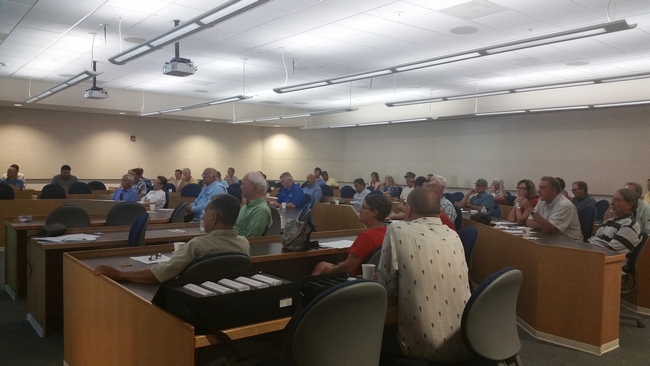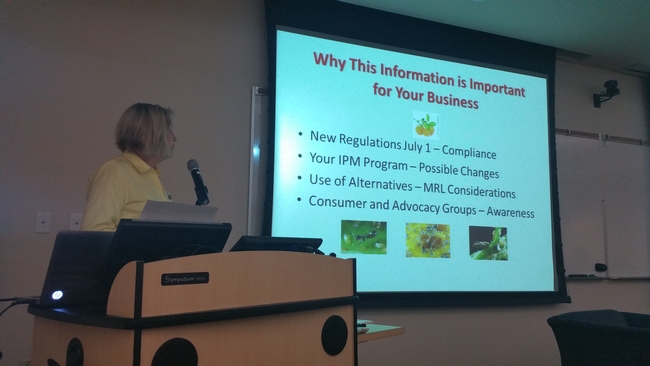
Posts Tagged: parasatoids
Biocontrol and Timing of Augmentative Releases
TYPES OF NATURAL ENEMIES
Parasites, pathogens, and predators are the primary groups used in biological control of insects and mites (Table 1). Most parasites and pathogens, and many predators, are highly specialized and attack a limited number of closely related pest species. Learn how to recognize natural enemies by consulting resources such as the Natural Enemies Handbook and the Natural Enemies Gallery.
Parasites
A parasite is an organism that lives and feeds in or on a host. Insect parasites can develop on the inside or outside of the host's body. Often only the immature stage of the parasite feeds on the host. However, adult females of certain parasites (such as many wasps that attack scales and whiteflies) feed on and kill their hosts, providing an easily overlooked but important source of biological control in addition to the host mortality caused by parasitism.
Although the term “parasite” is used here, true parasites (e.g., fleas and ticks) do not typically kill their hosts. Species useful in biological control, and discussed here, kill their hosts; they are more precisely called “parasitoids.”
Most parasitic insects are either flies (Order Diptera) or wasps (Order Hymenoptera). Parasitic wasps occur in over three dozen Hymenoptera families. For example, Aphidiinae (a subfamily of Braconidae) attack aphids. Trichogrammatidae parasitize insect eggs. Aphelinidae, Encyrtidae, Eulophidae, and Ichneumonidae are other groups that parasitize insect pests. It's important to note that these tiny to medium-sized wasps are incapable of stinging people. The most common parasitic flies are the typically hairy Tachinidae. Adult tachinids often resemble house flies. Their larvae are maggots that feed inside the host.
Pathogens
Natural enemy pathogens are microorganisms including certain bacteria, fungi, nematodes, protozoa, and viruses that can infect and kill the host. Populations of some aphids, caterpillars, mites, and other invertebrates are sometimes drastically reduced by naturally occurring pathogens, usually under conditions such as prolonged high humidity or dense pest populations. In addition to a naturally occurring disease outbreak (epizootic), some beneficial pathogens are commercially available as biological or microbial pesticides. These include Bacillus thuringiensis or Bt, entomopathogenic nematodes, and granulosis viruses. Additionally, some microorganism by-products, such as avermectins and spinosyns are used in certain insecticides; but applying these products is not considered to be biological control.
Predators
Predators kill and feed on several to many individual prey during their lifetimes. Many species of amphibians, birds, mammals, and reptiles prey extensively on insects. Predatory beetles, flies, lacewings, true bugs (Order Hemiptera), and wasps feed on various pest insects or mites. Most spiders feed entirely on insects. Predatory mites that feed primarily on pest spider mites include Amblyseius spp., Neoseiulus spp., and the western predatory mite, Galendromus occidentalis.
AUGMENTATION
When resident natural enemies are insufficient, their populations can sometimes be increased (augmented) through the purchase and release of commercially available beneficial species. However, there has been relatively little research on releasing natural enemies in gardens and landscapes. Releases are unlikely to provide satisfactory pest control in most situations. Some marketed natural enemies are not effective. Many natural enemies are generalist predators and are cannibalistic and feed indiscriminately on pest and beneficial species, thereby reducing their effectiveness.
Only a few natural enemies can be effectively augmented in gardens and landscapes. For example, entomopathogenic nematodes can be applied to control certain tree-boring and lawn-feeding insects. Convergent lady beetles (Hippodamia convergens) purchased in bulk through mail order, stored in a refrigerator, and released in very large numbers at intervals can temporarily control aphids; however, lady beetles purchased through retail outlets are unlikely to be sufficient in numbers and quality to provide control.
Successful augmentation generally requires advanced planning, biological expertise, careful monitoring, optimal release timing, patience, and situations where certain levels of pests and damage can be tolerated. Situations where pests or damage are already abundant are not good opportunities for augmentation.
A classic example of poor timing for augmentative release of predatory mites for control of broad mite in coastal lemon or persea mite in avocado is right now. Pest populations for the most part have soared and releasing predatory mites is little help. Predatory mites need to be releases into a small growing population, so in both of these cases it would have been better to start small, frequent releases early and throughout the spring to knock their populations back.
Adult predatory mite, Euseius tularensis, and citrus red mite.

predatory mite
Annual Citrus Grower Seminar in Southern California: A Review
The Citrus Research Board in conjunction with the University of California Cooperative Extension (UCCE) held their annual grower seminar on Tuesday, June 30, 2015 at the University of California, Riverside (UCR) Palm Desert Center. Seminars also took place in Santa Paula, CA on June 25th and in Exeter, CA on July 1st. Speakers from all over the state from different agencies shared their knowledge and expertise with the group.
Mark Hoddle, a Biological Control Specialist at UCR gave an update of the biological control of Asian citrus psyllid (ACP). The ACP's natural enemy, Tamarixia radiata has been successful since its release in Southern California in 2011. The Tamarixia kills the ACP nymphs either by parasitizing them (i.e., females eggs laid underneath ACP nymphs and the parasitoid larvae burrow into the nymph to feed which kills the pest) or by host feeding (i.e., female parasitoids stab the nymph with their ovipositor, a tube that they use to lay eggs, and they feed on the body juices that leak from these wounds. This kills the nymph too). Hoddle reminded us, in order for this biocontrol program to continue to be successful, ant populations must be controlled. ACP nymphs produce a white, sugary waste product called honeydew, a good carbohydrate source for the ants, therefore, the ants will protect the nymphs from Tamarixia. His current research showed that when an ant population is reduced, parasitism control increases significantly. Hoddle and his lab will be testing different organic and conventional pesticides for their efficacy against Argentine ants in citrus orchards.
For example, he is in the works of helping produce a more effective ant-bait by working on a biodegradable hydrogel. These hydgrogels are made from algae and crab shells. The material is engineered to encapsulate a 25% sucrose solution with a tiny amount of pesticide and ant pheromone. The liquid bait "leaks" onto the surface of the hydrogel, ants drink it, take it to the nest and slowly intoxicate the queen and nest mates. The baits, about the size of a jellybean, will be engineered to have a certain life time before they "dissolve". He anticipates these jellybean like baits being able to be broadcasted under trees (like you would slug/snail pellets) and the pheromone will attract the ants to them. Once they start to feed, the ants will lay down their own trails to the baits. Mark Hoddle is also the director of the Center for Invasive Species Research, for more information regarding his work on biocontrol, please visit: http://cisr.ucr.edu/.
Victoria Hornbaker, from the California Citrus Pest & Disease Prevention Program Manager and grower Curtis Pate, also the grower liaison from Imperial gave updates on the current ACP management areas (Fig. 1). Curtis, reminded the growers, ACP is attracted to bright colors, such as yellow. Yellow is a common color for most safety vests and jackets, this creates an issue because most people that own one of these pieces of clothing are unaware that they can very well be unknowingly transporting this pest to different locations (Fig. 2). Basic measures such as rolling up vehicle windows, shaking off clothing 
Lori Berger, with the UC Statewide Integrated Pest Management (IPM) Program gave an update on the Chlorpyrifos Critical Use Project (Fig. 3). The project is a multi-year effort to identify the pest management needs and practices for use of Chlorpyrifos in important crops in California. To accomplish this goal, Department of Pesticide regulation (DPR) contracted with UC IPM program to convene industry leaders to work together to create commodity specific guidelines for specific cropping systems. Chlorpyrifos is used on critical citrus pests such as ants, ACP, scales, bud mite, leafminers and many other arthropods. Growers are required to now obtain a restricted materials permit from their local County Agricultural Commission since DPR has designated the insecticide for restricted use in California as of July 1, 2015. The permit conditions may include buffer zones near sensitive sites, good management practices to reduce drift or offsite movement into the air and measures to reduce runoff into surface waters. For Southern California growers, a more in depth meeting will be held at the San Diego Farm Bureau in Escondido on September 15, 2015, more information on this meeting will available in the near future. DPR hours for laws and regulations will be available. More information on the Chlorpyrifos Critical Use Project can be found at: http://www.ipm.ucdavis.edu/IPMPROJECT/CDPR_Chlorpyrifos_critical_use_report.pdf.
Ben Faber, a UCCE Farm advisor from Ventura/Santa Barbra County gave a great presentation on how to interpret soils/water/leaf analyses and managing water in a drought. Soil and water reports are best used for identifying problems in: 1) pH (power of hydrogen); 2) salinity (how much salt is in the soil); 4) chloride (Cl-); 5) sodium (Na+); 6) boron (B); and 7) sodium adsorption ration. Most of the issues listed can be managed by leaching. Unfortunately, there are no definite measurements for fertility management of perennial crops, however, understanding the fundamentals of interpreting analyses is key for a healthy producing grove. For example, when one is handed a report, many may get overwhelmed by the sight of all these things that are reported. Many of those numbers are only on there because they are required to be there by law and may not have an importance to you as grower when it comes to management decisions. You may ask yourself, what is really important in all this? Faber, gave the growers a quick review, for example, in a water analyses we would want to look for look for some basic ranges in: Boron, this element should be no higher than 1 parts per million (ppm), sodium and chloride no higher than 100 ppm, and the TDS (total dissolved solids), this may also be known to some as EC (electrical conductivity), should be no higher than 1,000 ppm. Simple, right?
When dealing with pH, it is always best to balance that out before one plants trees. Trying to balance the pH after a crop has been established can be challenging and you may run the risk of injuring or killing your trees in the process. Those that would like to learn more on soils/water/leaf analyses and managing water in a drought, you can visit Ben Faber's UCCE County website: http://ceventura.ucanr.edu/Com_Ag/Subtropical/.
Neil McRoberts. Professor of Plant Pathology from UC Davis had interactive question and answer session with the audience, gathering grower's views on approaches of control for ACP/ Huanglongbing, also known as citrus greening disease. The answers to this survey will be helpful in creating a management plan to better help growers with their ACP treatment and preventative planning. Michelle Richey, assistant Director of Food Safety from Ott and Davison Consulting also gave a quick update on Food Safety and Good Agricultural Practices certification. She stressed on how important it is to keep records of everything that happens in a business and to have them accessible.
We had a great turn out and hope to see more growers at next year's Southern California meeting.



